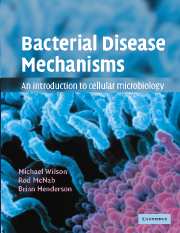Book contents
- Frontmatter
- Contents
- Preface
- Abbreviations used
- Chapter 1 An introduction to bacterial diseases
- Chapter 2 Bacterial cell biology
- Chapter 3 Molecular analysis of bacterial virulence mechanisms
- Chapter 4 Communication in infection
- Chapter 5 The mucosal surface: the front line of antibacterial defence
- Chapter 6 Immune defences against bacteria
- Chapter 7 Bacterial adhesion as a virulence mechanism
- Chapter 8 Bacterial invasion as a virulence mechanism
- Chapter 9 Bacterial exotoxins
- Chapter 10 Bacterial evasion of host defence mechanisms
- Chapter 11 Bacteria in human health and disease: the future?
- Appendix A Glossary of terms used
- Appendix B Brief descriptions of bacteria frequently mentioned
- Index
- Plate section
Chapter 1 - An introduction to bacterial diseases
Published online by Cambridge University Press: 05 June 2012
- Frontmatter
- Contents
- Preface
- Abbreviations used
- Chapter 1 An introduction to bacterial diseases
- Chapter 2 Bacterial cell biology
- Chapter 3 Molecular analysis of bacterial virulence mechanisms
- Chapter 4 Communication in infection
- Chapter 5 The mucosal surface: the front line of antibacterial defence
- Chapter 6 Immune defences against bacteria
- Chapter 7 Bacterial adhesion as a virulence mechanism
- Chapter 8 Bacterial invasion as a virulence mechanism
- Chapter 9 Bacterial exotoxins
- Chapter 10 Bacterial evasion of host defence mechanisms
- Chapter 11 Bacteria in human health and disease: the future?
- Appendix A Glossary of terms used
- Appendix B Brief descriptions of bacteria frequently mentioned
- Index
- Plate section
Summary
Aims
The principal aims of this chapter are:
to describe the normal microflora of humans
to discuss the role of the normal microflora in health and disease
to describe the types of interaction that exist between humans and bacteria
to outline some of the diseases caused by members of the normal microflora
to give examples of diseases caused by exogenous pathogens
to describe a classification system for infectious diseases based on the presence or absence of key virulence factors of the causative organism
to introduce the paradigm organisms – Streptococcus pyogenes and Escherichia coli
Introduction
Human beings display a tremendous range of attitudes to bacteria, ranging from a paranoid loathing accompanied by an ultimately futile determination to extinguish all ‘germs’ from the immediate environment to an admiring appreciation of their tremendously important role in the functioning of the biosphere. While a well-educated biologist will, one hopes, tend towards the latter attitude, when it comes to a consideration of infectious diseases, even s/he will often exhibit a response (bacteriophobia) more characteristic of the former. This retrenchment to a ‘them’ against ‘us’ confrontational attitude, while understandable, is not particularly helpful in trying to unravel the complexities of the origin of, and the mechanisms underlying, infectious diseases. What many people fail to realise is that, when it comes to viewing the bacterial world, it is not a case of ‘us’ and ‘them’ because we are, in fact, more ‘them’ than ‘us’.
- Type
- Chapter
- Information
- Bacterial Disease MechanismsAn Introduction to Cellular Microbiology, pp. 1 - 45Publisher: Cambridge University PressPrint publication year: 2002



